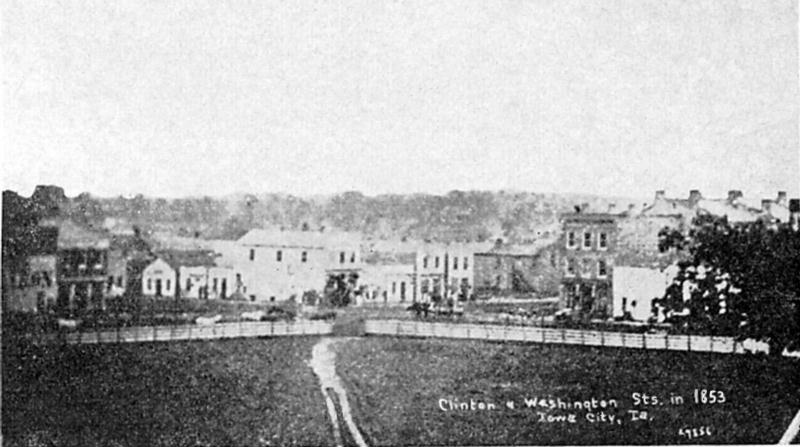|
|
|
Fencing that offered no opening at the Washington and
Clinton streets corner in the foreground in this image taken about 1890 |
|
|
|
Fencing demarks the southeast corner of the Pentacrest in
this 1853 image of Iowa City business district looking at what is now |
|
By Bob Hibbs Despite being the capital of
Iowa, Iowa City is a rip-roaring mess; a wide-open frontier town.
Livestock graze on the grounds surrounding the statehouse, muddy streets are chopped with ruts and littered with road apples, dogs roam in packs, pigs root at their leisure, and trash lines the gutter just beyond the boardwalk.
Hay is stacked along Iowa
Avenue just east of Clinton Street awaiting next Tuesday’s
sale. Three shots ring out from a
pistol fired into the air as celebrants leave a bar Sunday evening, riders
gallop away This is 1852 Iowa City; but,
it isn’t a matter needing Matt Dillon or Wyatt Earp.
The problem is utter lack of
city government; zero, nothing; everyone is free to use the public spaces as he
sees
There are no rules against
dogs and other animals running loose, no controls on bars or discharging
firearms. There is no speed limit, nor streets crew; no sanitation laws.
But, taxes are low. A
store-keep last year paid $2.85 in property tax. Why create another layer of
government The statehouse grounds are
fenced to keep horses and cattle away after years of
complaints. This situation is not
fictional; it really existed. Iowa City population was approaching 5,000 as
Iowa’s bustling capital city. The arguments against local government and
favoring low taxes won the day through four prior attempts during 14 years –
until conditions ripened into those described above. And,
worse! The open sore festered one
day about fall 1850 when a barkeep dumped a large batch of well-pickled
whiskey-flavoring cherries in the gutter in front of his establishment. Soon a
street sow and her brood were ravishing them. Piglets soon were chasing
their tails, filling the air with playful snorts, huffs and squeals as they
reeled about hardly able to stay on all fours. At the precise moment that a Sons
of Temperance meeting was breaking up, the mother sow is said to have keeled
into the gutter with a resounding splash, leaving the piglets to ogle passersby “Even the beasts,” exclaimed
one of the Sons. The following week
witnessed inauguration of the “Society for City
government came into being April 6, 1853 in a mayor-council form under
special legislative charter, which was abandoned in 1864 in favor
of incorporation under general state law. The council-manager form was
adopted nearly a century later. Jacob
De Forest was the first mayor; Anson Hart recorder, C.H. Buck
treasurer, Robert Hutchinson marshal and Benjamin King assessor.
The council consisted of nine alderman – Edwin Lanning, William Hunt
and E.C. Lee representing the first ward; Thomas Snyder, F.P.
Brossart and W. Penn Clarke the second, and Peer Roberts, Peter
Stetzer and J.R. Van Fleet the third. The
first session of the new council began the process of adopting 13
ordinances, including ones providing for cleaning sidewalks and
streets, prohibiting discharge of firearms in town, taxing dogs and
prohibiting them running at large, appointing a streets
commissioner, prohibiting hay stacks on streets, controlling bars
and gambling, prohibiting speeding in town called “fast riding and
driving of buggies,” preventing nuisances (such as free-running
livestock, and other unrelated matters), preventing desecration of
Sabbath and creating a board of health. Wouldn’t serving as a public
official have been a breeze during “the good old days?” Next
Saturday:
Clinton Street a century ago. Bob Hibbs
collects local postcards and researches history related to them. |

